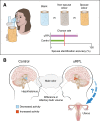A possible link between olfaction and miscarriage
- PMID: 32988454
- PMCID: PMC7524547
- DOI: 10.7554/eLife.62534
A possible link between olfaction and miscarriage
Abstract
Unexplained repeated pregnancy loss is associated with an altered perception of male odors and differences in brain regions that process smells.
Keywords: Bruce effect; human; miscarriage; neuroscience; olfaction; pregnancy block; repeated pregnancy loss; social chemosignaling.
© 2020, Borak and Kohl.
Conflict of interest statement
NB, JK No competing interests declared
Figures

Comment on
-
Unexplained repeated pregnancy loss is associated with altered perceptual and brain responses to men's body-odor.Elife. 2020 Sep 29;9:e55305. doi: 10.7554/eLife.55305. Elife. 2020. PMID: 32988456 Free PMC article.
References
-
- Rantala MJ, Eriksson CJP, Vainikka A, Kortet R. Male steroid hormones and female preference for male body odor. Evolution and Human Behavior. 2006;27:259–269. doi: 10.1016/j.evolhumbehav.2005.11.002. - DOI
Publication types
MeSH terms
LinkOut - more resources
Full Text Sources
Medical

